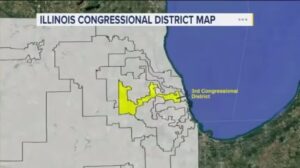
In 2021, Illinois Democrats—with full control of the state legislature and governor’s office—drew new congressional maps. These maps earned a scathing “F” grade from the Princeton Gerrymandering Project, which assessed the map’s partisan fairness, geography, and overall competitiveness. The grading found that the new maps:
Created only three Republican-held seats, despite the state’s nearly 44% vote share for Trump in 2024.
Yielded 14 Democratic and 3 Republican districts, effectively diluting GOP influence and packing Republican voters into fewer districts.(turn0search6)
Were extremely non-compact, splitting counties and distorting geography, undermining any appearance of fairness.(turn0search2)
Key Details & Fallout
The Princeton Project labeled all three grading categories—partisan fairness, geographic integrity, and competitiveness—as failures (“F”). No Illinois district was deemed competitive.(turn0search6)
Compared to a neutral baseline map, researchers determined that Democrats engineered the map to gain three extra seats at the expense of Republicans. Only Texas matched that level of partisan advantage.(turn0search6)
Illustrative examples included bizarre district shapes—one stretching from central Illinois to the Wisconsin border, another slicing Cook County into unnatural configurations.(turn0search7)
⚠️ Why It Matters
These tactics highlight that gerrymandering is bipartisan—Democrats are equally adept when in power.(turn0search7)
The map’s design eliminated almost all competition, reducing accountability and thinning public choice.(turn0search6)
Illinois political leaders, including Gov. JB Pritzker, have since been accused of hypocrisy—promising independent commissions yet signing this partisan map into law.(turn0news12)
Quick Facts Snapshot
Feature Detail
Map Grade “F” from Princeton Gerrymandering Project
District Breakdown 14 Democrats vs. 3 Republicans
Competitive Seats Zero
Gerrymandering Tactic Packing GOP voters into fewer districts; contorted boundaries
Leadership Role Entirely drawn and passed by Democrats
Takeaway
What Illinois Democrats drew in 2021 wasn’t just a map—it was a strategy. It systematically marginalized opposition and cemented partisan control, all under a process later condemned by nonpartisan analysts.
Share this:





